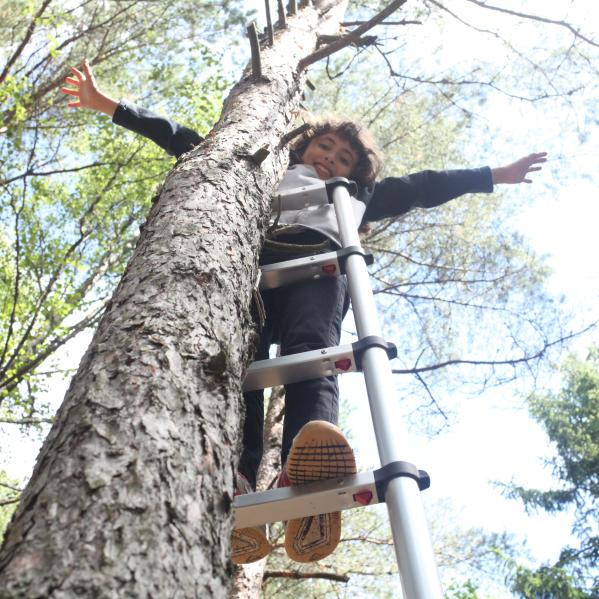Free play!

A playful life
Play is most often associated with children. Because children's play can be seen and heard! Children play as much as they can and they play almost anywhere. For the child, play is vital – a child who cannot or does not want to play needs help. Playing follows us throughout life – it just takes on different expressions.
The little child plays for themself with the available things. They test how the immediate environment works with an adult within reach. After a few years, the child plays with other children and explores what reality and imagination are together with playmates. Places where children themselves can influence, stimulate and develop games, where the child and the environment interact. After a few more years, the child embarks on a journey of discovery and explores how boundaries and rules of the game work – how far away can and dare I go on my own? At the end of childhood, the child searches for their own identity. Belonging to a group is then important.
The young person, like everyone else, wants to be seen and look at others, but also to be able to withdraw and be solitary. It is especially important when young people develop their identity by trying what it is like to be and act in different ways. The adult world often perceives the subcultures that arise as threatening. The subcultures question the rules and lifestyle of adults and the adult world's response is, therefore, to try to control them in different ways.
But adults also need to play! Unfortunately, it is not often that adults let go of control and throw themselves into the unknown where you have to decide the rules yourself and be free. Play can in many ways seem to be the exact opposite of adults' way of life. Is that why adults sometimes look down on the play and think it is unimportant? Play is by nature self-rewarding and voluntary. Play challenges the limits of what is possible. Play is freedom, imagination and community. Play should not be evaluated! If someone judges those who play – "how nice you play" – the game can come off immediately. Those who play do it entirely for their own sake. Playing is the point!
Adults may call their play a creative hobby – or they may play by testing a new identity at parties or events. The desire to play probably remains throughout life, but it can be inhibited. Maybe adults just think that play is not suitable for certain professional roles or is good for one's status? But surely both the world and we humans could have become both bigger and richer if we allowed ourselves to play from time to time!

A playful city
Often, the built playground symbolizes play in the city. The playground signals that children are welcome and safe here, but what does the playground say about our view of play? Which spots are truly the best playgrounds? If we plan, design and develop the whole city for and together with children, there might not be a need for playgrounds. Is the time ripe to plan the city that way?
Play does not need expensive play equipment. On the contrary, a lack of ready-made pieces of equipment can be a source of creativity. Nature or areas with trees and shrubs often provide unbeatable opportunities for ingenuity. Sticks, stones and other finds can be used to build and become props in the game. It is easier to play together in environments where the roles are not predetermined. Nature and abandoned places provide such opportunities, building a hut or playing shop is an example of play where all children can participate and find a task. Surveys show that up to the age of seven, girls and boys use the public space equally, but then boys dominate the places to 80 percent. Because play is as important to girls as it is to boys, this is serious.
It is important to plan for children and young people to be able to move freely in the city. The older children get, the further away from home they should be able to take care of themselves – yes, a young person must be able to grow up to be an independent individual. If there is a network of playgrounds where children can take themselves and move, they can – as they grow and get older – move further and further away from their home and school and discover their neighbourhood and eventually their entire city.
Just because children play everywhere and with everything, they can find does not mean that we can ignore what it looks like where children grow up. No matter how strong the desire to play is, not all environments work equally well for play. Playing has taken place in nature for thousands of years, and such play environments are still difficult to beat due to their richness and complexity.
On the constructed playground, it is usually clear how the child or young person is expected to play. The play equipment is designed to be used in a certain way and therefore limits the play. The term KFC playgrounds (KFC stands for Kit, Fence, Carpet) was coined by the British researcher Helen Woolley and describes playgrounds with fixed play equipment within a fenced surface and with a base of art material. In such a place, there is not much for a child to discover or change. Studies have shown that children do not play for a very long time with ready-made play equipment. They get bored and try to develop the game into something different. Can you get up the slide instead of down? Does gravel roll down the slide as fast as a rock?
In play, children examine the laws of physics and the properties of materials. A good playground has both small and large surfaces and a variety of different types of materials. There are both places to be active in and places where you can retreat, the opportunity to influence and a variety of vegetation that provides an interplay between sun and shade. It is based on such experiences and sensory experiences that children accumulate experiences that remain well into adulthood. Can you remember where you played as a child?

Helsingborg as a forerunner
Helsingborg is one of the Swedish cities that has become known for its playgrounds. In the late fifties and ten years ahead, the city of Helsingborg invested in experimental and slightly revolutionary construction playgrounds for children and young people. In the early 2000s, play environments were developed in plantations where children could design their own places and control maintenance.
Important municipal officials in these development projects were the city gardeners Arvid Bengtsson and Stig Billing as well as preschool teacher Marianne Billing. Based on their own experiences of how free and exciting it was to play in their own growing environment in the countryside and on deserted plots in the city. With inspiration from Denmark, several construction playgrounds were developed in Helsingborg where there were employed play leaders. The city sought and gathered knowledge and experience on how to build innovative playgrounds in the best way so that they worked all year round and did not disturb those who lived right next door. It was a period when a curious and experimental exploration took place with the goal that the municipality would meet children's needs for exciting play environments.
During the early 2000s, Helsingborg participated in the European project "NeighborWoods" focused on democracy and communication within the management of urban forests. Together with researchers from SLU, students from Sally Bauerskolan got to develop their own places in afforestation near their school. The aim was to make the children co-creators and strengthen their sense and responsibility for the green local environment. The children got to learn how different plants react to pruning and how wildlife is affected at the same time as they got to learn how to work with real tools. By thinning and pruning, space can be formed and everything that has been thinned away can be used as a building material for huts, fences and balance play. The children who participated were in grades 1–5, but older students in grade 8 also participated. Later in the project, the older students were given the confidence to be supervisors for the municipal al maintenance team. The children's ideas made a deep impression on the work team. They understood that the children wanted to create places and realized that there were lots of different possibilities instead of just following a care template.